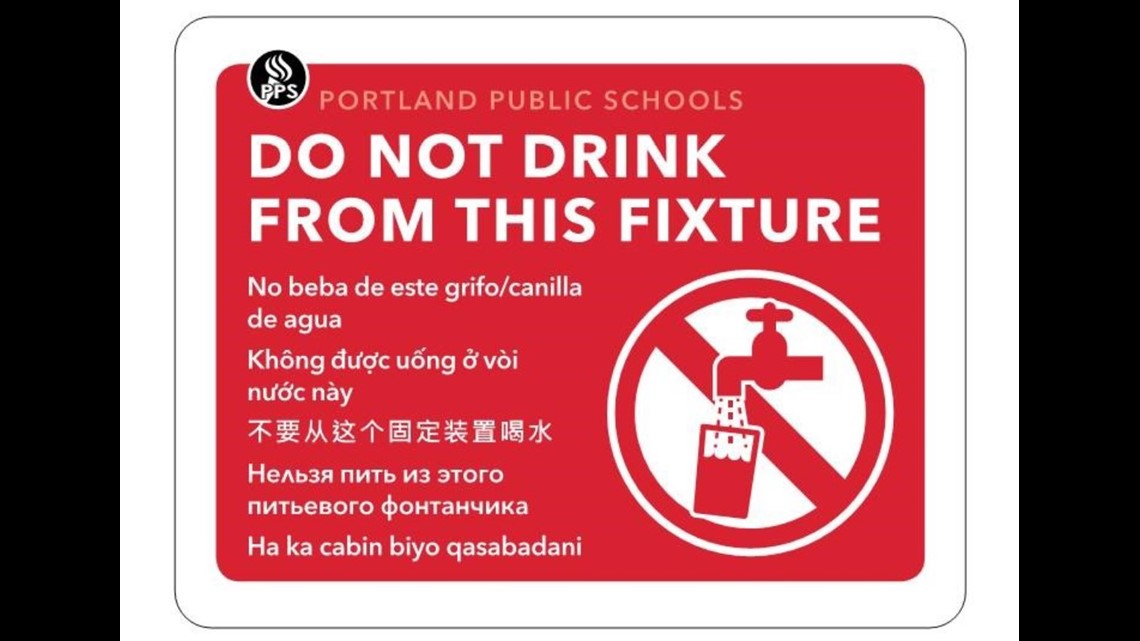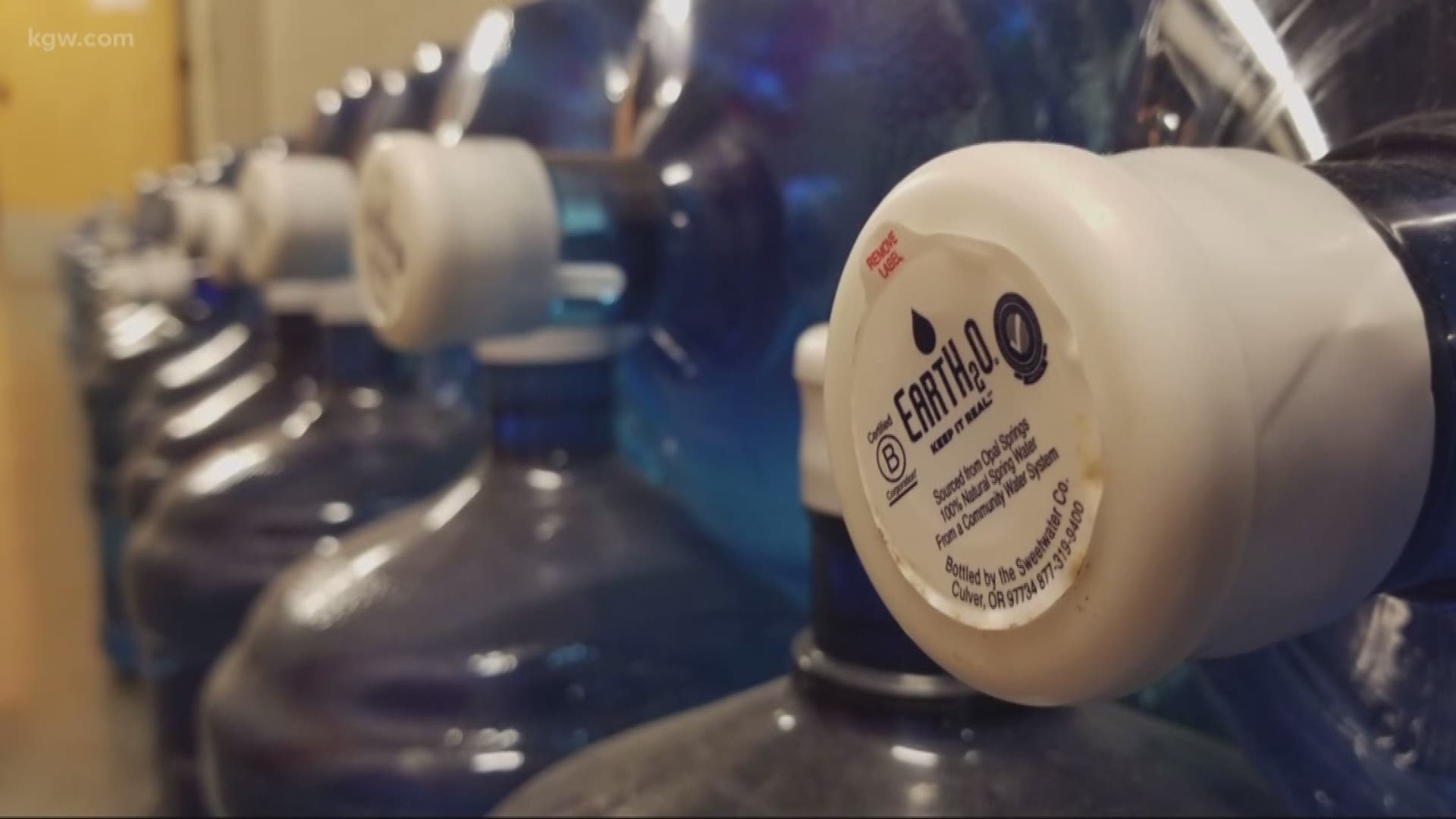Portland, Ore.— Portland Public Schools is still spending $825,000 a year on bottled water service and cups, even though many drinking fountains have already been fixed.
PPS is in the process of replacing fixtures on water fountains and kitchen faucets in schools, after tests revealed high lead and copper levels in water district-wide.
Tests in the spring and summer of 2016 showed high lead and copper levels in many drinking faucets, sinks, and water spigots. Lead and copper are neurotoxins and can cause serious health problems, especially for children.
Taxpayers passed a $790 million bond measure in May 2017, with the assurance that PPS would fix lead issues in the city’s schools.
Background: High lead levels found in Portland schools
The district put bottled water in schools starting in May 2016.
Two years after the lead problems became public, many Portland schools still have big bottled water jugs and paper cups for kids to use.
Invoices obtained through a public records request show the district pays an average of $68,800 for water delivery service every month.
The district has not reduced its spending on bottled water, even though it’s spent about $5 million so far getting nearly 500 drinking fountains turned back on in 30 schools.
The monthly invoices, submitted by water supplier EARTH20, also include charges for disposable cups. Over the past year, the district has spent $226,419 on paper cups.
In April alone, the district paid $19,980 for disposable, single-use cone cups.
Some schools that had fixtures repaired are still getting five-gallon jugs of water delivered, district officials confirm.
Why is bottled water still in all schools?
Even though water fountains and kitchen faucets have been fixed at a third of the district’s 90 schools, the water hasn’t been deemed safe in every room.
The $790 million bond allotted about $28 million to fix “all centralized drinking fountains,” according to Joe Crelier, Director of Risk Management at PPS.
By centralized, PPS means drinking fountains in hallways and gymnasiums. But classroom sinks, where kids used to fill up personal water bottles before the lead tests, weren’t included in that initial plan.
He said some schools that have had centralized fountains replaced want to keep their bottled water close to classrooms.


“It’s feedback from the schools,” Crelier said. “There are classrooms with younger students, where you simply don’t send them down the hall on their own to get a drink or fill a water bottle. There’s more need for it – for the water right in the classroom – so getting a drink of water is not a distraction to learning.”
Since August 2016, PPS has spent about $1.3 million on bottled water, Crelier said.
PPS is not using bottled water for kitchen preparation in schools that haven’t had kitchen faucets fixed, according to PPS spokesman Harry Esteve. Instead, “district protocol calls for extensive flushing each day before they are used,” he said.
He said the flushed water has been tested and is safe to use.
When will lead issues be fixed district-wide?
Portland Public Schools knows there are lead and copper issues in every single school. What they didn’t know at first was how to fix them. The heavy metals could just be coming from the fixtures on water fountains – an easy fix. Switch out the fixtures, and the lead problems go away.
More costly would be pipe issues, as many of Portland’s older schools may have lead pipes carrying water to drinking sources. That could involve tearing into walls to replace plumbing.
The district came up with a plan to fix the schools in six waves, so they can replace fixtures on centralized drinking fountains at a dozen or so schools at a time and then test those schools to see if the lead problems went away. (See below for what schools are in each wave.)
The district has replaced fixtures on water fountains in the first four waves of schools, and tested those fixtures in two waves so far. Out of the 30 schools that have been worked on, about a dozen fixtures still had levels that were higher than the Environmental Protection Agency’s action level of 15 parts per billion.
At Beverly Cleary at Fernwood, a gym fountain that was fixed had lead levels at 239 parts per billion.
The fountains that still tested higher than the EPA’s action level have not been turned on, Esteve said. The district will look at whether pipes need to be replaced at those locations, or if it would be more cost-effective to add a new fountain near the old one.
The district expects centralized fountains and kitchen sinks to be fixed by the start of the 2018-19 school year.
“We fully expect at least this first round of hallway and common area fixtures to be replaced and working,” Esteve said.
What about classroom sinks?
There is no specific pot of money to fix lead problems in classroom sinks. But so far, the water fountain fixes are costing less than planned since most have been easy fixes. If there’s money left over after all of the fountains are replaced, that money will be used to fix some kitchen sinks.
“With the cost avoidance of not having to tear into walls, the working group here within PPS is strategizing how to circle back and replace fixtures in some classrooms,” said Crelier. “That would be the classrooms for the lower grade levels, Special Ed, classrooms where food preparation may have to occur.”
Crelier said the district is working on a timeline now to figure out when some sinks can be replaced.
But there’s no guarantee there will be any of the $28 million left over for sink replacements. Even if some sinks are replaced, there is a possibility that bottled water will remain indefinitely in some PPS schools.
Below is a list of all schools in each group. Group 1-2 has had centralized fountains replaced and tested. Group 3-4 has had fountains replaced but not tested yet. Groups 5-6 have yet to be replaced. Group 7 is a low priority because they are administrative offices, and may not be fixed.
GROUP 1
G1 Applegate
G1 Astor
G1 Atkinson
G1 Beverly Cleary/Fernwood
G1 Chapman
G1 Chief Joseph
G1 Hayhurst
G1 Lewis
G1 Meek Professsional Technical
G1 Richmond
G1 Rose City Park
G1 Sacajawea
G1 Skyline
G1 West Sylvan
G1 Woodstock
GROUP 2
G2 Beach
G2 Boise-Eliot
G2 Chavez
G2 Clarendon
G2 Creston
G2 George
G2 James John
G2 Jefferson
G2 King
G2 Ockley Green
G2 Peninsula
G2 Rosa Parks
G2 Sitton
G2 Vernon
G2 Woodlawn
GROUP 3
G3 Alameda
G3 Beaumont
G3 Cleveland
G3 Rigler
G3 Harrison Park
G3 Hollyrood
G3 Irvington
G3 Laurelhurst
G3 Lee
G3 Madison
G3 Roseway Heights
G3 Sabin
G3 Scott
G3 Tubman
G3 Vestal
GROUP 4
G4 Arleta
G4 Benson
G4 Bridger
G4 Clark (Creative Science School)
G4 Glencoe
G4 Holladay Center
G4 Kelly
G4 Lane
G4 Lent
G4 Marysville
G4 Mt Tabor
G4 Sunnyside
G4 Whitman
G4 Woodmere
G4 Youngson
GROUP 5
G5 Abernathy
G5 Buckman
G5 Capitol Hill
G5 Duniway
G5 Grout
G5 Hosford
G5 Jackson
G5 Lincoln
G5 Llewellyn
G5 Markham
G5 Monroe/Da Vinci
G5 Sellwood
G5 Stephenson
G5 Wilson
G5 Winterhaven
GROUP 6
G6 Ainsworth
G6 Bridlemile
G6 East Sylvan
G6 Forest Park
G6 Grant @ Marshall
G6 Gray
G6 Maplewood
G6 MLC
G6 Rieke
G6 Columbia
G6 Edwards
G6 Green Thumb
G6 Humboldt
G6 Kenton
G6 Terwilliger
GROUP 7
G7 Holladay Annex
G7 BESC
G7 Rice
G7 Wilcox
G7 Smith
G7 Washington/ DEQ (Auto Shop)

